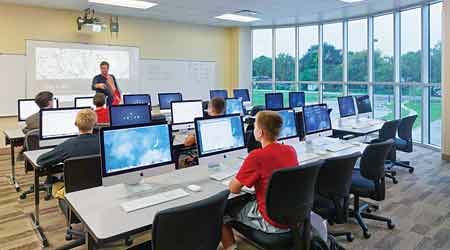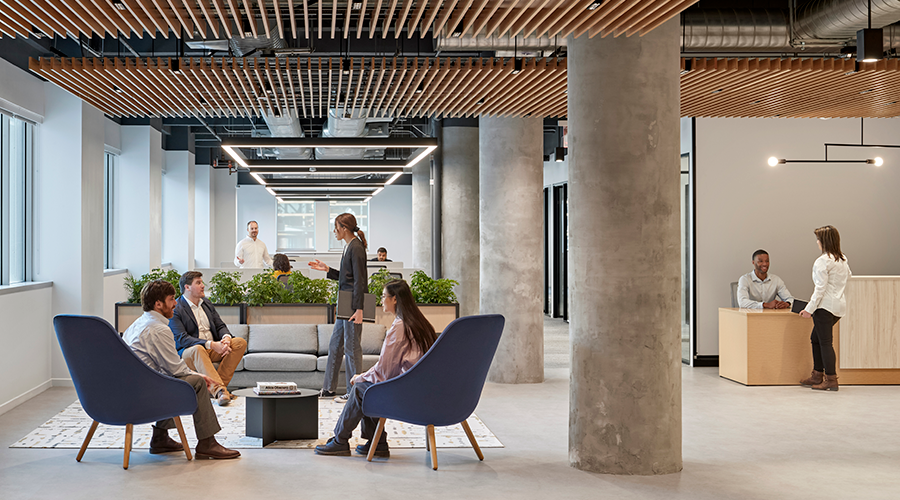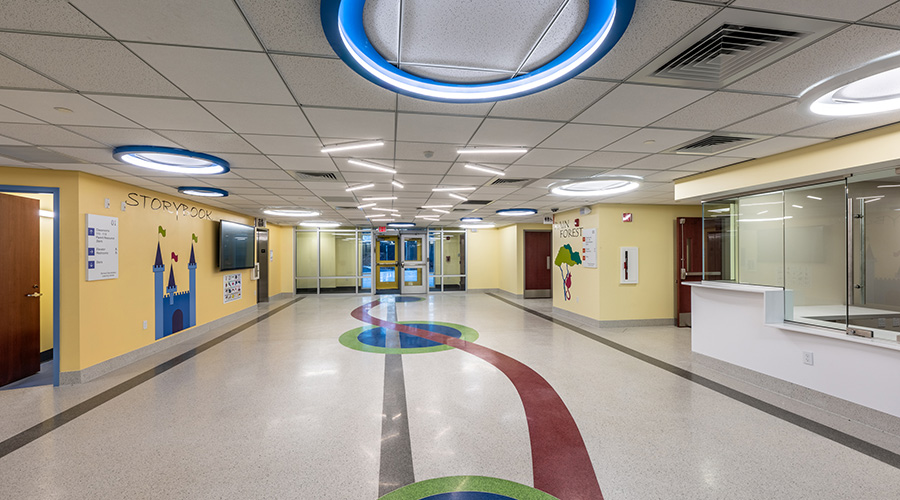 At Gretna High School in Gretna, Neb., 65 percent of teachers use
classroom projectors every class period or daily. Positioning large windows away from projection surfaces minimizes the projection wash out effect.Alistair Tutton Photography
At Gretna High School in Gretna, Neb., 65 percent of teachers use
classroom projectors every class period or daily. Positioning large windows away from projection surfaces minimizes the projection wash out effect.Alistair Tutton PhotographyUnderstanding the Next Stages of Sustainability in K-12 Schools
The strong connection between the built environment and human health means sustainability goals must move beyond the traditional efforts to conserve resources.
Sustainability has moved beyond resource conservation efforts to include climate change, human health and well-being, resilience, regeneration, and ecosystem integrity. Such a broadened definition of sustainability today requires new perspectives in processing competing design parameters to provide a holistic solution that values the health of end users, the immediate local communities, and the larger ecosystems.
Design should start with discussions about how sustainability can enhance the human experience. A growing body of research shows a strong connection between the built environment and the health and well-being of those who occupy the space. When it comes to buildings, user experience (UX) encompasses the totality of the effects felt by a user as a result of interaction with the building. This includes the influence of usability, usefulness and emotional impact during interaction, and savoring the memory after interaction.
More succinctly, good UX design creates a positive emotional and psychological connection to the location. The goal should be to focus on the experience first, and then create a sustainable building around that experience. This can be achieved by a “VALUES” approach: Viewing Architecture through the Lens of User Experience for Sustainability. This solution, adaptable and scalable, evaluates sustainable design and its impact on user experience.
In the visioning sessions for Canyon View High School, the integrated design team, including faculty, district leadership, community members, and students, participated in a collaborative exercise to explore values related to key sustainability aspects of building design, construction, and operation. They explored five broad categories: environmental stewardship, the indoor environment, indoor air quality / health of occupants, student-centric design, and beyond buildings (site, concrete, bike paths, etc.). Under each category, a set of topics was introduced with examples illustrating the concept and reinforcing its importance. The team prioritized each category based on UX on a scale of 0 to 10 with 10 being critically important to the success of the school.
Through the phases of facility visioning, program verification, and early design, one theme emerged: The district’s vision of “all students, college and career ready” would rally stakeholders to amplify existing success and cultivate instructional evolution. Driven by this vision, the design progressed from a concept to include many design strategies that impact UX, the end result of which will be a 21st century learning facility that not only encourages high-energy, spontaneous collaboration between students and teachers, but also propels human health and resource conservation.
A key strategy that is a direct result of VALUES is the design of the outdoor space, referred to as the agora. Transition space between classrooms is as important as the classrooms themselves. The design of the agora provides a variety of thermal zones for extending outdoor usage, a variety of learning spaces of various sizes, access to nature by applying biophilic design principles, and solar shade structures.
At the end of the day, buildings have a direct impact on the occupants who inhabit them. Those involved in the design of those facilities have a responsibility to provide healthy, sustainable environments where students can excel, and where taxpayers agree how to appropriate funds spent. Significant strides have been made in the past decade to reduce energy consumption by advancing planning, design, and construction efforts, yet there is so much more that can be accomplished together. Being an informed decision maker is the first step. Understanding sustainability and how to implement even the smallest of concepts into a campus will make all the difference in the world.
Prem Sundharam (psundharam@dlrgroup.com), AIA, LEED AP BD+C, serves as the global sustainability leader at DLR Group, which designed Zellwood Elementary School, Gretna High School, and Canyon View High School. He leads firm-wide performance based design initiatives and develops long-term strategies for a more environmentally responsible design practice. He is a Certified Energy Manager, a certified Building Energy Modeling Professional and has taught courses on net-zero energy design and simulation.
Email comments to edward.sullivan@tradepress.com.
Related Topics:














